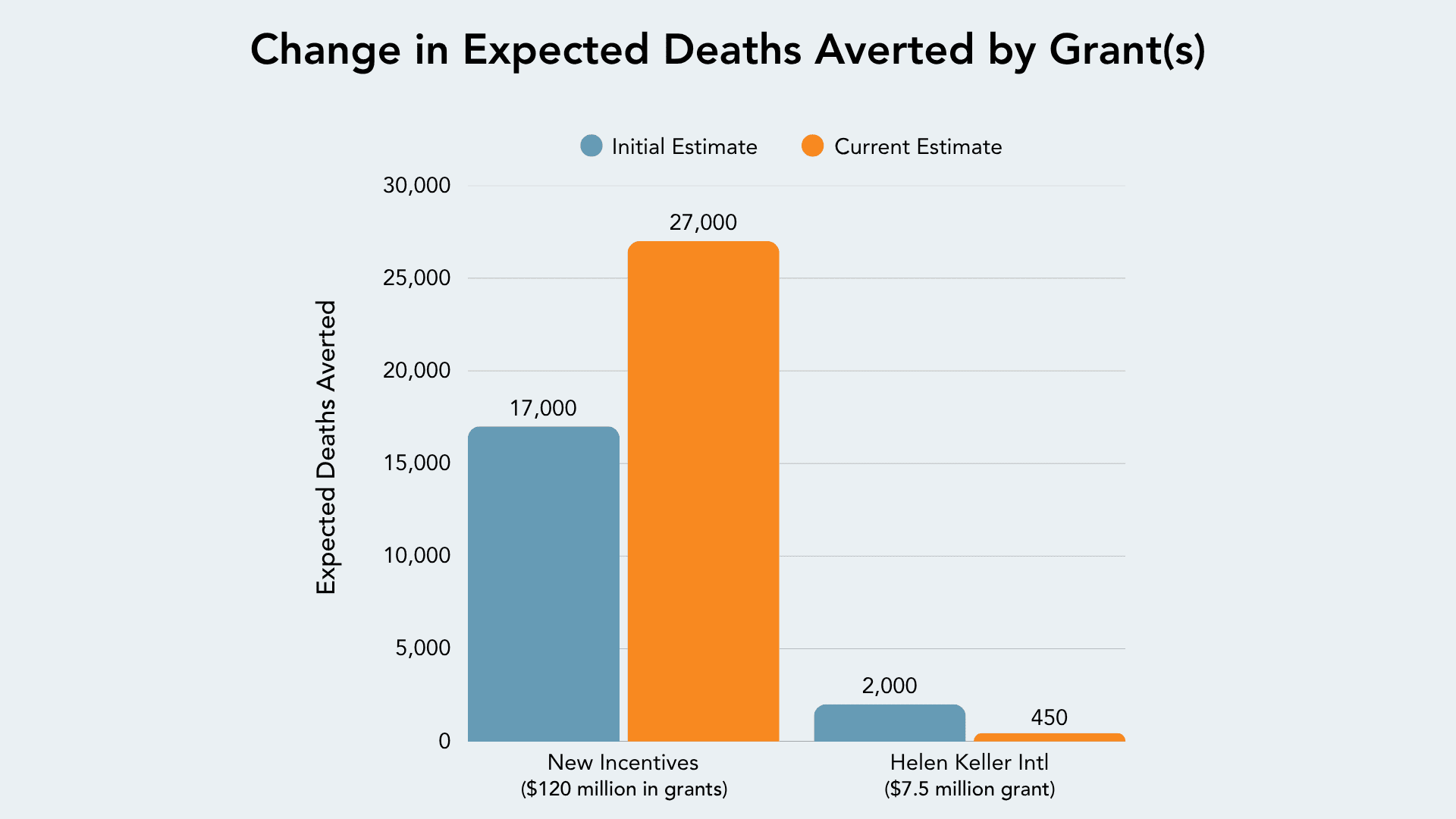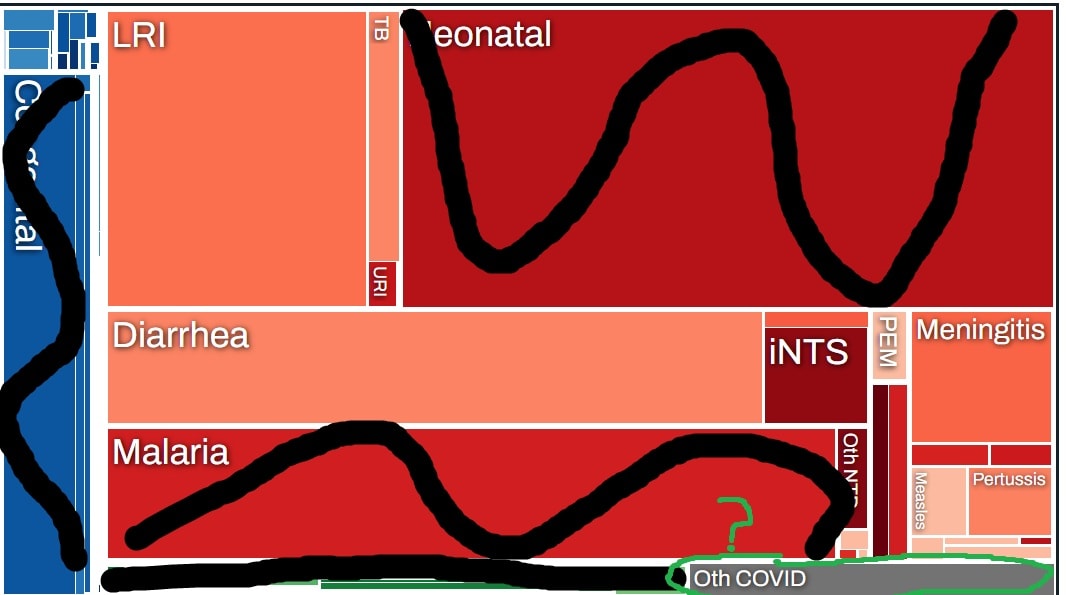TLDR: On a VERY rough Sanity check[1], GiveWell’s New Incentives “lived saved” estimate seems twice as high as is plausible.
On seeing this wonderful graph from a GiveWell Back-check of New Incentives, I thought to myself wow New Incentives saved 27,000 lives - that’s impressive but feels high.

So I decided to spend a surprisingly fun 90 minutes of my life doing a back-check of a back-check. The things I do for joy...
Due to the speedrun nature of this check, I might have got a basic input wrong, made a simple logical mistake or even a calculation error. Also note that even if New Incentives did only save half, or a quarter as many lives as GiveWell estimates, they would still be a very cost-effective charity!
My Sanity Check BOTEC[2]
I tried to estimate the upper end of what might be plausible, as this is only a sanity check and to be generous to the might of the vaccine.
How Many kids did New Incentives cause to be vaccinated?
GiveWell estimates that 81 percent of incentivized kids would be vaccinated anyway, meaning roughly one child in five is an “additional” vaccination attributable to New Incentive’s programs, So Of 1,500,000 kids - GiveWell estimate 81% would have been vaccinated anyway
That’s 285,000 kids who were vaccinated because of New Incentives program - amazing!
What percent of those lives would be saved by Vaccination?
1. GiveWell estimated that 27,000 lives were saved by New Incentives. That’s 9.5% of the kids they caused to be vaccinated, which already seems highish - GiveWell estimates about 1 in 10 of these kids would have died from a vaccine preventable illness before age 5 if not for the New Incentives program.
2. The hardest part of my sanity check might be estimating a high bound on the mortality rate of unvaccinated kids. Recent Nigerian Mortality data from DHS estimates child mortality across Northern Nigeria to be 10-15%, but I’m going to double this estimate for unvaccinated kids to 25%, or 1 in 4 kids[3]. I think this is likely higher than reality, but a decent upper bound for a sanity check.
3. About half of under 5 deaths in Nigeria happen around birth and in the first 2 months of life so are not preventable by vaccines. In unvaccinated kids this percentage will be lower (as more will die of vaccine-preventable conditions later on), so I’m going to drop this estimate to ⅓ of total deaths. Malaria deaths make up 16% of under 5 deaths. This will be far higher in Northern Nigeria as malaria burden is disproportionately high there - ChatGPT found 2 studies which estimated malaria causes 30-50% of under 5 mortality in Northern Nigeria. But this percentage will be lower in unvaccinated kids, because more kids will die of vaccination-preventable diseases. So on balance I’ll leave it at 16% and estimate that…
Birth + Neonatal + Malaria deaths make up about 50% of under 5 deaths. These deaths couldn't be prevented through vaccination
So this means 12.5% of unvaccinated kids might die from Non-birth/neonatal and Non-Malarial causes. The New Incentives estimate of 9.5% would mean that 75% of these deaths would have to be prevented by their program for the GiveWell estimate to hold, which I don’t think is possible because as good as vaccines are, they don't prevent everything....
We account for the remaining Mortality
Global Burden of Disease mortality visual for Nigeria, under 5
Now we estimate Vaccine preventable deaths from what’s left.
From what remains, the big 3 baby killers are Pneumonia, Diarrhea and Meningitis (see above GBD visualisation)
- Pneumococcus causes about 23 % of meningitis and hemophilus causes about 20%. So lets say 50% preventable at upper bound
- Rotavirus vaccine might prevent 30% of Diarrhea deaths, although this is tricky to estimate.
- Again giving too much credit, vaccines might prevent 40% of pneumonia deaths.[5]
On the bottom right of the GBD visualisation are a few diseases that are almost 100% vaccine preventable, including Measles, Pertussis, Tetanus and Diptheria[6]. iNTS is Non-typhoid Salmonella and currently not vaccinated for - someone invent one please? Maybe 50% of the remaining burden could be prevented by vaccines.
So again being generous to vaccines, maybe 40% of what remains might have been prevented by the wonderful New Incentives program
So this means of the remaining 12.5% of kids who would have died after accounting for Malaria and birth issues, about 5% might be preventable. This is still an impressive percentage, but only about half of GiveWell’s estimates - and by my methods at least is on the high end of what's possible.
GiveWell take a completely different approach, meticulously going through disease by disease to estimate mortality reduction for each vaccine-preventable disease. I haven’t gone through their estimation step by step to try and find out why we come to such different conclusions, as that would take far longer than the 90 minutes I spent here! This is also not a cost-effectiveness analysis.
Again I could easily have wasted my time and be just flat wrong here. I would love any feedback of course especially from @GiveWell or New Incentives.
- ^
Maybe the loosest set of calculations I’ve done in recent years
- ^
Also a line in my recent EA-themed rap track
- ^
If these kids all would have had zero vaccination doses, you could argue this rate could be higher, but that wouldn't be the case.
- ^
As a side note, GBD estimated that 2% of under 5 deaths in Nigeria is from Covid - that’s absurd and impossible can someone please sort this out!
- ^
https://www.nature.com/articles/s41564-019-0562-y
- ^
This isn’t entirely true, for example quite a number of kids die from Pertussis in the first few months of life before the vaccines grant full immunity

Thanks for doing this check!
This seems very different from what they claim in their spreadsheet (300 under-5 deaths averted per 10,000 children counterfactually vaccinated, so 3%)
Do you have a sense of what's driving the discrepancy?
Thanks Lorenzo - yes looking at that now I think that 3% is the estimate for the highest under 5 mortality Nigerian state as well, others are far less. They do assign 40% of the value of the program to preventing death in other ages + increased income effects as well + 0.75 lives saved for every vaccinated kid's life saved, based on other life saving effects from vaccines (which I'm pretty dubious about) - but that doesn't change the situation enough.
Also not sure if you have seen it, but near the top of this page is a great overall summary of their calcul... (read more)